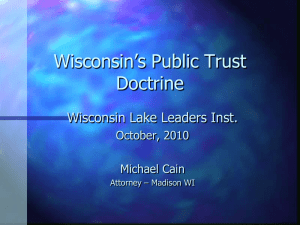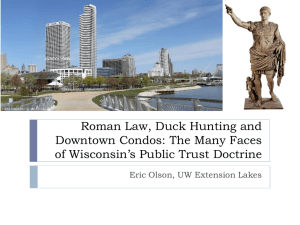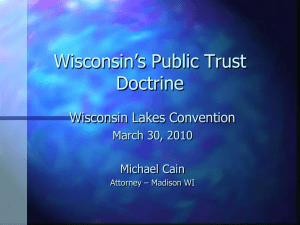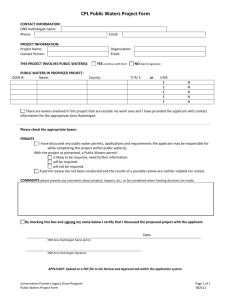Protecting Public Trust Waters under WI‟s Public Trust Doctrine Lake Leader’s Institute
advertisement
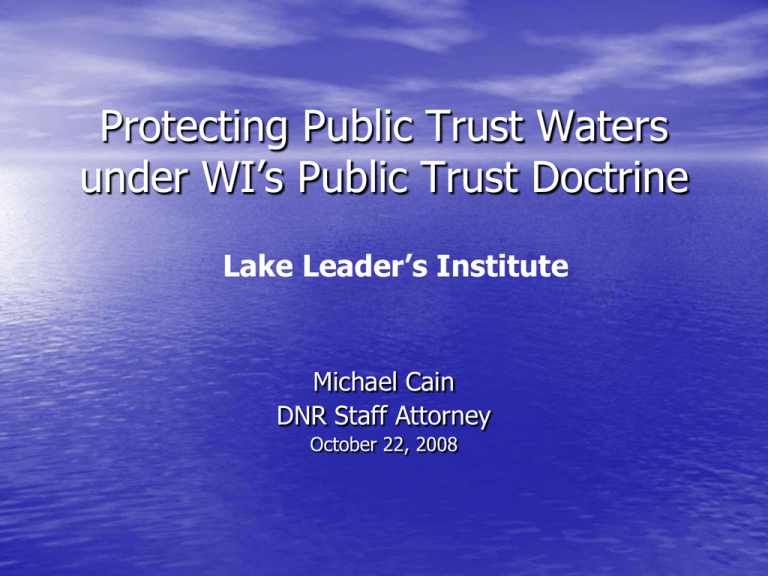
Protecting Public Trust Waters under WI‟s Public Trust Doctrine Lake Leader’s Institute Michael Cain DNR Staff Attorney October 22, 2008 Public Trust Doctrine • Emanates from the WI Constitution, Article IX, Section 1 • Sizable body of common law, which holds all navigable waters in trust by the state for the public • State has an affirmative duty to protect and preserve these public trust waters Why is it important today? Historic floods in WI- August, 2007 Impacts to public trust waters? Rock Island?? Low water levels raise many issues re: use of shoreline, vegetation removal, invasives, dredging. Stormwater runoffHow does it affect public trust waters and resources? The Public Trust Doctrine provides the foundation for preserving aquatic natural resources for future generations. Importance of the public trust doctrine has increased as aquatic resources have diminished and recreational and development pressures have increased. Affects potential recreational use of all waters which has major implications for tourism and recreation industries. Rights of Riparian Owners• Owners of property on lakes and stream are called “riparians” • They have the right to access the shore and make “reasonable use” of the shore and the waterway • These private rights are limited, however, by the public rights in waters Developed shoreline circa 1960‟s Developed shoreline circa 1990‟s Competing Uses in the Littoral Zone Frogs link aquatic and terrestrial food chains. Healthy amphibian populations depend on minimally disturbed riparian and littoral zones. Diverse plant community Disappearance of plant community due to large pier Why does it matter? Yellow perch eggs draped over aquatic plants. Habitat attributes are necessary to sustain populations- Voss, et al. Applied Population Laboratory University of Wisconsin, Madison Voss, et al. Applied Population Laboratory University of Wisconsin, Madison Voss, et al. Applied Population Laboratory University of Wisconsin, Madison Northwest Territory “The navigable waters leading into the Mississippi and St. Lawrence, and the carrying places between the same shall be common highways, and forever free, as well as to the inhabitants of said territory, as to the citizens of the United States, and those of any other states that may be admitted into the confederacy, without any tax, impost or duty therefore.” Northwest Ordinance of 1787 Article IV Right of the Public to Fish in Navigable Waters Willow River v.Wade(1877) Diana Shooting Club v. Husting (1914) • Recognition of the Public Nature of Navigable Waters • Need to broadly construe the trust doctrine so that “people reap the full benefit of the grant secured to them” • State “became a trustee charged with the faithful execution of the trust created for their benefit.” • “Wisdom of the policy which steadfastly and carefully preserved to the people the full and free use of public waters cannot be questioned. Nor should it be limited by narrow constructions.” Recognized Public Uses Nekoosa Papers v. Railroad Commission ( 1930) “Enjoyment of Scenic Beauty is a Public Right” Muench v. PSC (1951) Necessary to look at water quality impacts before issuing water regulation permits. Reuter v. DNR (1969) Protected Public Trust Uses: • Commercial Navigation • Boating • Fishing • Hunting • Scenic Beauty • Fish and Wildlife Habitat • Water Quality and Quantity Statutory Limitations Statutes • • • • • • • • • • • ss. 24.39/30.11- Bulkhead lines- leases s. 13.097- Review of Lakebed grants s. 30.13(1) - Wharves, Piers, Swimming Rafts s. 30.12 - Structures and Deposits (piers, boat shelters) s. 30.232 - Boathouses and houseboats s. 30.123 - Bridges s. 30.19 - Grading on the bank, ponds s. 30.20 – Dredging s. 87.30-Floodplain zoning ss. 281.32 and 59.962-Shoreland zoning s. 283.33- Storm Water Discharge Permits “The legislature has no more authority to emancipate itself from the obligation resting upon it . . . to preserve for the benefit of all the people forever the enjoyment of the navigable waters within its boundaries, than it has to donate the school fund or the state capitol to a private purpose. “ Priewe v. WI Land & Improvement Co. (1899) State v. PSC, 1957 • Public bodies must • • control Devoted to public trust purposes and open to the public Minimal area relative to waterway State v. PSC • Public uses of • waterway not destroyed or greatly impaired Loss of public rights negligible compared to public trust benefit Madison v. State, 1957 Hixon v. PSC, 1966 Two prescribed standards: • “Material obstruction to navigation” • “Not detrimental to the public interest” “A little fill here and there may seem to be nothing to become excited about. But one fill, though comparatively inconsequential, may lead to another, and another, and before long a great body may be eaten away until it may no longer exist. . . . ” “Our navigable waters are a precious natural heritage; once gone, they disappear forever.” Hixon v. PSC Claflin v. DNR, 1972 “The essential determination must be whether this particular boathouse in this precise situation is „detrimental‟ to the public interest . . . It is entirely proper that natural beauty should be protected . . . “ Impairment of natural beauty by itself can serve as the basis for determining a project is “detrimental to the public interest.” „An owner of land has no absolute… right to change the essential natural character of his land so as to use it for a purpose for which it was unsuited in its natural state….” Just v. Marinette, (1972) Village of Menomonee Falls v. DNR, 1987 • Historically, State of WI allowed channelization of streams in SE WI • Policy modified in late 1980‟s due to recognition of adverse impacts • Need to consider comprehensive planning process when reviewing permits and when considering the cumulative impacts of projects. • ”. . . aesthetic values of a meandering stream with pools and riffles, lined with natural vegetation. . .” • “Project would have a detrimental impact on the wildlife by eliminating cover and food sources and lessening the creek‟s value as a travel corridor for wildlife.” State v. Trudeau 1987 Project site, while not “navigable in fact,” was below the OHWM of Lake Superior and was protected public trust lakebed. Once OHWM is established, the wetlands, marshes, and shallow areas which are not „navigable in fact,‟ are still protected. State may seek abatement of violations of floodplain zoning and may enjoin public nuisances. State has will and means to enforce public trust doctrine. Sterlingworth v. DNR, 1996 Cumulative impacts- development since 1920‟s Public rights involved- spawning, water quality & aquatic plants ”Although nine additional boat slips may seem inconsequential to a proprietor such as Sterlingworth, we approach it differently. Whether it is one, nine or ninety boat slips, each slip allows one more boat which inevitably risks further damage to the environment and impairs the public‟s interest in the lakes…” “In our opinion, the DNR, in limiting Sterlingworth‟s permit … carried out its assigned duty as protector of the overall public interest in maintaining one of Wisconsin‟s most important natural resources.” Sterlingworth v. DNR Hilton v. DNR- 2006 WI 84 • • • • • • Involved back lot development- Green Lake 77 feet of frontage, 38 owners 1966- 6 slips; 2000- 22 slips, 249 feet long DNR took action- reduced to 11 slips Supreme Court upheld decision- citing fishery, wildlife, aquatic plants, safety, natural scenic beauty, and reasonable use Court reiterated Sterlingworth standards Hilton- continued • In a concurring opinion, Justice Prosser agreed with the majority, but stated: “This cases epitomizes the growth of agency power, the decline of judicial power, and the tenuous state of property rights in the 21st century.” What does the 21st century hold for evolution of the Public Trust Doctrine? Wetland Issues State of WI adopted water quality standards for wetlands in 1991, which applied to all wetlands in the state. NR 103, WAC- The adoption of the rule was controversial. Nearly 3,000 people participated in the rule process. The rule became effective on August 1, 1991. 70 • 61% supported the 60 • • 40 rule 27% opposed the rule 12% appeared “as interest may appear” 50 30 20 10 0 APPROVED Written responses Impacts of NR 103 • Pre-NR 103 approximately 1440 acres of wetland per year were lost thru COE permits • After NR 103, approximately 328 acres per year lost (including highways) • NR 103 review process has improved planning and avoidance of wetland impacts Great Lakes Coastal Issues • What is an acceptable public trust use? • How do we assure the project is public and not commercial? • How do we protect shorelands and wetlands • What are the issues for the future? Milwaukee Art Museum Pier Wisconsin Ashland Ore Dock Covers 4 acres of lakebed The future? Pioneer Inn- Oshkosh- Not a Great Lake issue- but similar issues Sturgeon Bay- condos “over” the bay Phase I Port Vincent Golf and Residential DevelopmentLake Michigan -Originally- 56 acres of lakebed fill proposed -Current proposal- 20 acres of fill material -Creates some public amenitiesbut raises significant questions re: alternatives that will not result in loss of public trust waters -Is under review by State and Federal agencies Phase I Commercial and Residential Proposals on lakebed- • Bayfield • Superior • Kenosha • Racine • Milwaukee • Sheboygan • Two Rivers Key points• There are limited mechanisms to allow public trust uses on lakebed • No entity, including the Legislature, can authorize uses which abdicate the public trust • Lakebed areas, even after they are filled, remain public lakebed, subject to the public trust doctrine Emerging Issues Rock Island?? What is public land here? Nuisance conditions due to invasives and algae. Removal of algae, vegetation and mussell shellsNR 345, WI Adm. Code Great Lakes Water LevelsWhere are they headed? 2007 Southern Wisconsin Flood Damage Does this affect habitat and the public trust? While protection of life, health and property are critically important are important, do these issues overlap with public trust doctrine concerns? The direct effects of Stormwater violations on public trust waters and resources are obvious. Are the shoreland zoning and wetland rules important for the future of the public trust doctrine? Energy Issues- Wind, Thermal 6 Boats x 8.5’ = 51’ 3 piers x 6’ = 18’ 100’ Total shoreline length covered by boat/piers = 69’ 100’ Pier Boat 100’ 100’ What are we marketing? Is this the future? Will my son‟s children enjoy fishing WI waters? What will the next 300 years bring? • The issues are complex, with many competing interests • As trustee, the State of WI, has a solemn responsibility to all the citizens of the state • The Courts, the Legislature, the Executive Branch will impact this future • Citizens must be actively involved “All ethics so far evolved rest upon a single premise; that the individual is a member of a community of interdependent parts. His instincts prompt him to compete for his place in that community, but his ethics prompt him also to cooperate (perhaps in order that there may be a place to compete for).” Aldo Leopold The most important motive for work…in life is pleasure in work, pleasure in its result and the knowledge of the value of the result to the community. Albert Einstein

